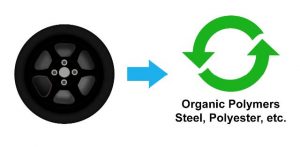New chemistry to recycle vulcanized rubbers back to organic polymers

Tech ID
19-057
Inventors
S. Zheng
M. Liao
Y. Chen
M. A. Brook
Patent Status
PCT application filed
Stage of Research
Proof of principle data available
Contact
Paul Grunthal
Business Development Manager
Abstract
With a global demand for tires expected to reach 3.2 billion units by 2022, we can expect rubber waste from these facilities to increase as well1. Most automotive rubber tires are vulcanized (crosslinked by sulfur) to make them hard-wearing, and there are no highly efficient means of converting the rubber back into useful organic polymers. Instead, these rubbers are used for energy production, processed into crumb for relatively low value applications or pyrolyzed to make recover some of the hydrocarbons; in many jurisdictions, they are collected or sent to land fills.
Researchers at McMaster have developed a mild and efficient method to break the sulfur-sulfur bonds that hold these vulcanized rubbers together to recover the organic polymers originally used to make the tire; they may be reused to create new products. The inorganic components in such rubber products (e.g. carbon black, metal wires, etc.) can also be readily separated and reused for a variety of applications.
Applications
- Recycling tire rubber in the automotive industry
- Recovery of organic polymers from vulcanized rubbers
Advantages
- Mild and efficient method to recycle vulcanized rubbers
- Recovery of organic polymers for sustainable reuse of vulcanized rubbers within tires and other applications
- Recovery of other tire constituents – steel, cord, fillers – for reuse
- Reduction of safety hazards and environmental impact of stockpiled tires and landfills
News and Media
References
- Global Tires Report (https://www.freedoniagroup.com/industry-study/global-tires-3687.htm). Freedonia Group 2019, Industry Study 3687.

